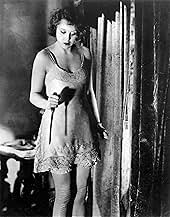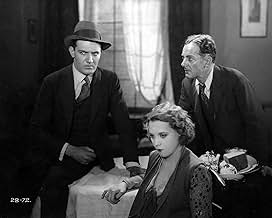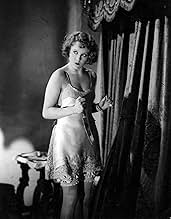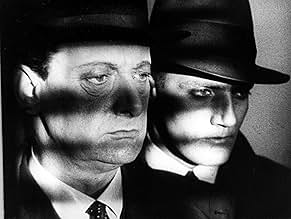IMDb RATING
6.9/10
13K
YOUR RATING
After killing a man in self-defense, a young woman is blackmailed by a witness to the killing.After killing a man in self-defense, a young woman is blackmailed by a witness to the killing.After killing a man in self-defense, a young woman is blackmailed by a witness to the killing.
- Awards
- 2 wins total
Ex-Det. Sergt. Bishop
- The Detective Sergeant
- (as Ex-Det. Sergt. Bishop - Late C.I.D. Scotland Yard)
Johnny Ashby
- Boy
- (uncredited)
Joan Barry
- Alice White
- (voice)
- (uncredited)
Johnny Butt
- Sergeant
- (uncredited)
Alfred Hitchcock
- Man on Subway
- (uncredited)
Phyllis Konstam
- Gossiping Neighbour
- (uncredited)
Sam Livesey
- The Chief Inspector (silent version)
- (uncredited)
Phyllis Monkman
- Gossip Woman
- (uncredited)
Percy Parsons
- Crook
- (uncredited)
Featured reviews
While remembered as the first sound picture made by Alfred Hitchcock (or anyone else in Britain), there is much more to "Blackmail" than merely historical interest. It reveals the director's subtle creativity, with a carefully structured story that also produces some real suspense, with one of Hitchcock's best cameos and an entertaining chase sequence as bonuses. The movie has a unique feel, as Hitchcock was still using many silent film techniques at the same time that he was experimenting with sound. Not all of this works perfectly, but it does not detract from the film's many positive features.
Alice White (Anny Ondra, voice dubbed by Joan Barry) goes out for the evening with her boyfriend, who is a police detective (John Longden). When they have a series of minor quarrels, Alice decides to go her own way, and meets an artist friend. The artist's intentions are obvious, but Alice is innocently unaware. When he brings her to his studio, there is soon an unpleasant confrontation that sets in motion a turbulent series of events.
The story is carefully constructed not just to produce suspense but also to raise interesting questions in the viewer's mind. Alice feels a terrible sense of guilt and fear over what has happened - communicated to the viewer in a variety of creative ways - but of what is she really guilty? The behavior of the detective boyfriend is partly well-intentioned, but he certainly is not faultless. The moral ambiguity is often subtle, because it takes a back seat to the suspense, and it takes a couple of viewings to appreciate all that is going on.
There is a particularly nice symmetry to the beginning and ending, pointing to the greater significance of the action in between. The opening sequence (filmed in silent movie style) shows the detective and his partner dealing with a suspect in a routine way, not caring about him as a person. In the final scenes, when the detective must help Alice make a final report on everything that has happened, he sees his job in a far different perspective.
"Blackmail" is of the darker type of Hitchcock, like "Notorious" or "Vertigo". While clearly made in a different era, it has the same kind of depth and craftsmanship that distinguished those later, more well-known masterpieces.
Alice White (Anny Ondra, voice dubbed by Joan Barry) goes out for the evening with her boyfriend, who is a police detective (John Longden). When they have a series of minor quarrels, Alice decides to go her own way, and meets an artist friend. The artist's intentions are obvious, but Alice is innocently unaware. When he brings her to his studio, there is soon an unpleasant confrontation that sets in motion a turbulent series of events.
The story is carefully constructed not just to produce suspense but also to raise interesting questions in the viewer's mind. Alice feels a terrible sense of guilt and fear over what has happened - communicated to the viewer in a variety of creative ways - but of what is she really guilty? The behavior of the detective boyfriend is partly well-intentioned, but he certainly is not faultless. The moral ambiguity is often subtle, because it takes a back seat to the suspense, and it takes a couple of viewings to appreciate all that is going on.
There is a particularly nice symmetry to the beginning and ending, pointing to the greater significance of the action in between. The opening sequence (filmed in silent movie style) shows the detective and his partner dealing with a suspect in a routine way, not caring about him as a person. In the final scenes, when the detective must help Alice make a final report on everything that has happened, he sees his job in a far different perspective.
"Blackmail" is of the darker type of Hitchcock, like "Notorious" or "Vertigo". While clearly made in a different era, it has the same kind of depth and craftsmanship that distinguished those later, more well-known masterpieces.
A common motif in Alfred Hitchcock's movies is the guilty woman: "Blackmail", "Psycho" and "The Birds" are all prime examples. In "Blackmail", Alice White (Anny Ondra) goes home with an artist one night and he tries to rape her. She murders him, and from then on everything reminds her of it. The jester painting appears to be looking at her (or she at it?), a billboard looks like a knife, and a woman keeps uttering the word knife. But in the end, everything blows up in Alice's face.
Hitch was certainly showing his chops here. The camera angles, scenery, and other such things all combined to make what we would expect in a Hitchcock movie. I try to imagine being a moviegoer in 1929 watching "Blackmail" for the first time, wondering what Hitchcock's subsequent work would be like.
Hitch was certainly showing his chops here. The camera angles, scenery, and other such things all combined to make what we would expect in a Hitchcock movie. I try to imagine being a moviegoer in 1929 watching "Blackmail" for the first time, wondering what Hitchcock's subsequent work would be like.
One of Hitchcock's early films, it was one of the first films to come out of England with sound during the end of the silent film era. An interesting film, we see several great shots of dolly's with the early staircase scene. Several well shot montages with wonderful dissolves and sound bridges. For 1929, Hitchcock shows the world with the film that he's a talented film maker. A risky scene, the audience gets to watch the main actress of the film undress behind her curtains. While the murder is never seen, the provocative and private scene of her undressing is present. Another interesting note, the main character of the film is the murderer! Throughout the film, the audience judges whether or not she is an innocent murderer or a killer. Hitchcock makes an early name for himself with this film with toying with the audience throughout the suspense of the film.
Saw this for the first time the other night on Turner Classic network. The movie is really is a "proto-Hitchcock" style; You could catch a glimpse of the future "Bruno" (Robert Walker, Strangers on a Train) in the blackmailer. I suppose we can discuss character development and so on, but after all it was 1929,the first British talkie, and therefore at the beginning of a whole new concept. The scenes in the artist's bedroom were certainly risqué by American standards at the time. I understand the movie initially began as a silent film and a silent version was indeed filmed. Probably every future Hitchcock twist and turn in the plot is in there and I found it quite enjoyable.
Britain's first talkie, the 1929 "Blackmail," is directed by Alfred Hitchock, and even back then, it has many of his touches. The stars are Anny Ondra, Cyril Ritchard, John Longden, and Sara Allgood.
A young woman (Ondra) two-times her Scotland Yard inspector boyfriend (Longden) and goes out with an artist (Ritchard). Things get rough in his apartment, and he forces himself on her.
She kills him (a la Dial M for Murder). Her boyfriend finds her glove in the apartment and realizes she did it; the other glove was found by a criminal hanging around the artist's apartment building, and he decides to blackmail the inspector.
Hitchcock more than appears in this film; he has a bit with a little boy on a subway. The film is strange in that the beginning is silent with no title cards. Then suddenly, there is sound.
It moves quite slowly, with not much in the way of action. The story builds slowly, and the scene in the artist's apartment is quite long before anything happens.
Nevertheless, the Hitchcock touches are there. A pivotal scene happens at the British Museum - Hitchcock's upheaval in familiar places. And in the jail scene, there's a sound the director often described as being terrifying in his childhood when his father had the local police teach him a lesson - the jail door closing.
The very pretty Ondra, wife of boxer Max Schmelling, is dubbed here. Ritchard in 1929 is not recognizable as Captain Hook.
Worth seeing - it's early Hitchcock and it's an 80-year-old movie. Mind-boggling.
A young woman (Ondra) two-times her Scotland Yard inspector boyfriend (Longden) and goes out with an artist (Ritchard). Things get rough in his apartment, and he forces himself on her.
She kills him (a la Dial M for Murder). Her boyfriend finds her glove in the apartment and realizes she did it; the other glove was found by a criminal hanging around the artist's apartment building, and he decides to blackmail the inspector.
Hitchcock more than appears in this film; he has a bit with a little boy on a subway. The film is strange in that the beginning is silent with no title cards. Then suddenly, there is sound.
It moves quite slowly, with not much in the way of action. The story builds slowly, and the scene in the artist's apartment is quite long before anything happens.
Nevertheless, the Hitchcock touches are there. A pivotal scene happens at the British Museum - Hitchcock's upheaval in familiar places. And in the jail scene, there's a sound the director often described as being terrifying in his childhood when his father had the local police teach him a lesson - the jail door closing.
The very pretty Ondra, wife of boxer Max Schmelling, is dubbed here. Ritchard in 1929 is not recognizable as Captain Hook.
Worth seeing - it's early Hitchcock and it's an 80-year-old movie. Mind-boggling.
Did you know
- TriviaMuch of the filming originally was shot silently. When sound became available during the course of shooting, Sir Alfred Hitchcock reshot certain scenes with sound, thus making it his first talkie. There was one complication with this change, however. Leading lady Anny Ondra had a thick Czech accent which was inappropriate for her character, Alice White. Joan Barry was chosen to provide a different voice for her, but post-production dubbing technology did not exist then. The solution was for Barry to stand just out of shot and read Alice's lines into a microphone as Ondra mouthed them in front of the camera. [This is a major plot point of Chantons sous la pluie (1952), which is set in the era of movie studios moving from silent pictures to talkies.] This generally is acknowledged as the first instance of one actress' voice being dubbed by another, even though the word "dub" is technologically inappropriate in this case.
- GoofsAt about 0:24:30 when Crewe (Cyril Ritchard) is talking to Alice (Anny Ondra), he calls her "Anny" before correcting himself.
- Quotes
Alice White: You and your Scotland Yard! If it weren't for Edgar Wallace, no one would ever have heard of it.
- Alternate versionsOriginally filmed as a silent movie, running 75 minutes; Hitchcock later added newly shot scenes and had other existing footage dubbed to create a talkie version, running 86 minutes.
- ConnectionsEdited into Der Zinker (1931)
- SoundtracksMiss Up-to-Date
(1929) (uncredited)
Words by Frank Eyton and music by Billy Mayerl
Performed by Cyril Ritchard
- How long is Blackmail?Powered by Alexa
- Are the first eight minutes supposed to be silent?
- Why are the picture and sound so bad?
- Is this film really in the U.S. public domain?
Details
Box office
- Gross worldwide
- $160
- Runtime1 hour 25 minutes
- Color
- Aspect ratio
- 1.20 : 1
Contribute to this page
Suggest an edit or add missing content



































